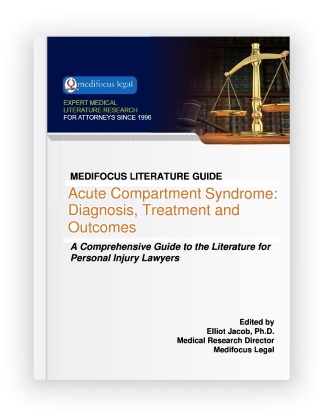Acute Compartment Syndrome: Diagnosis, Treatment and OutcomesA Comprehensive Guide to the Literature for Personal Injury Lawyers
Publisher: Medifocus Legal
Publication Date: January 22, 2020
Number of Pages: 129
A Comprehensive Guide to the Literature for Personal Injury Lawyers
Publisher: Medifocus LegalPublication Date: January 22, 2020
Number of Pages: 129
Acute compartment syndrome is typically caused by a serious injury such as a fracture or crush injury. This condition is a surgical emergency because without prompt diagnosis and treatment, it can lead to permanent muscle damage. Other causes of compartment syndrome may include:
- Severe muscle bruising
- Constricting bandages or casts
- Eschar formation from burns
- Use of anabolic steroids
- Intravenous drug injection
- Vascular surgery to the arms or legs
- A blood clot in a vessel of the arm or leg.
The hallmark sign of compartment syndrome is pain that usually more intense than what would typically be expected from the injury itself. Other symptoms may include tingling or burning sensations in the skin (paresthesia), swelling, bruising, a tight muscle, and numbness or paralysis. The latter two features are late signs of compartment syndrome and are usually indicative of permanent tissue injury.
The diagnosis of compartment syndrome is a clinical one and is based on the type of injury, the signs/symptoms, and a physical examination of the patient. When compartment syndrome is suspected, direct measurement of pressures within a body compartment can confirm the clinical diagnosis. A delay in diagnosis can lead to devastating complications for the patient including rhabdomyolysis, limb gangrene, progressive kidney failure, and ultimately death.
Acute compartment syndrome is considered a surgical emergency. The goal of treatment is to relieve the excessive pressure within the compartment to prevent loss of limb and life. Treatment consists by perfoming a fasciotomy whereby a surgeon creates long incisions in the skin and through the fascial layer to relieve the excessive pressure underneath. In general, studies have shown that outcomes after fasciotomy are best when there is no significant delay in treatment.
A missed diagnosis of acute compartment syndrome leading to delayed fasciotomy often results in significant morbidity to the patient and may result in the filing of a medical malpractice claim against the provider. The outcome of litigation of these cases hinges on proving that the treating physician breached the prevailing standard of care within a given locality regarding the diagnosis and treatment of compartment syndrome.
The MediFocus Literature Guide to Acute Compartment Syndrome: Diagnosis, Treatment, and Outcomes was created to provide attorneys with a detailed overview of the published medical literature about acute compartment syndrome so that they will be better prepared to argue the critical issues that will be contested at trial. The Guide includes nearly 200 journal article references with links to the abstracts and focuses on the diagnosis, treatment, and outcomes for acute compartment syndrome of both the upper and lower extremities as well as the abdomen. The Guide also includes a valuable Author Directory for quickly identifying and locating medical experts with specialized knowledge about acute compartment syndrome.
 |
- A comprehensive bibliography of 188 journal article references indexed in MEDLINE published in well respected medical and scientific journals.
- Online access to the abstracts (summaries) of the articles.
- A unique "Author Directory" consisting of the names and institutional affiliations of experts who have published and have specialized knowledge about Acute Compartment Syndrome: Diagnosis, Treatment and Outcomes. The "Author Directory" is a valuable resource for quickly identifying and locating experts for case reviews, opinions, and testimony.
Select examples of topics that are covered by the articles referenced in this Guidebook include:
- Delayed Fasciotomy Is Associated with Higher Risk of Major Amputation in Patients with Acute Limb Ischemia.
- Acute Traumatic Compartment Syndrome of the Forearm: Literature Review and Unfavorable Outcomes Risk Analysis of Fasciotomy Treatment.
- Evaluation and Management of Acute Compartment Syndrome in the Emergency Department.
- Acute Compartment Syndrome: Do guidelines for diagnosis and management make a difference?
- Extremity compartment syndrome following blunt trauma: a level I trauma center's 5-year experience.
- The compartment syndrome: is the intra-compartment pressure a reliable indicator for early diagnosis?
- Compartment Syndrome of the Hand.
- A prospective study of surgical outcomes and quality of life in severe foot trauma and associated compartment syndrome after fasciotomy.
- A sneaky surgical emergency: Acute compartment syndrome. Retrospective analysis of 66 closed claims, medico-legal pitfalls and damages evaluation.
- Compartment syndrome after gynecologic operations: evidence from case reports and reviews.
- Foot compartment syndrome: diagnosis and management.
- Incidence and predictors for the need for fasciotomy after extremity trauma: a 10-year review in a mature level I trauma centre.
- Acute compartment syndrome of the leg: pressure measurement and fasciotomy.
- Acute tibial compartment syndrome following spine surgery.
- Abdominal compartment syndrome in vascular surgery - A review.
- Acute compartment syndrome--a life and limb threatening surgical emergency.
- Rhabdomyolysis associated with compartment syndrome resulting in acute renal failure.
- Lower limb acute compartment syndrome after colorectal surgery in prolonged lithotomy position.
- Compartment syndrome: time from diagnosis to fasciotomy.
- Is acute compartment syndrome avoidable?
is available in two formats: | |
Order by Phone:To order by phone, please call: Order by Mail:To order by mail, please print and complete this Order Form | |

